
RD Sharma Solutions for Class 9 Maths Chapter 12 Heron’s Formula
Hey, are you a class 9 student and looking for ways to download RD Sharma Solutions for Class 9 Maths Chapter 12 "Heron’s Formula"? If yes. Then read this post till the end.In this article, we have listed RD Sharma Solutions for Class 9 Maths Chapter 12 in PDF that is prepared by Kota’s top IITian’s Faculties by keeping Simplicity in mind.
If you want to learn and understand class 9 Maths Chapter 12 "Heron’s Formula" in an easy way then you can use these solutions PDF.
Chapter 12 of RD Sharma Class 9 deals with famous Heron’s formula which is used for finding the area of a triangle in terms of its three sides. If you want to improve your basic in Heron’s Formula, then you can use this.
RD Sharma Solutions helps students to Practice important concepts of subjects easily. RD Sharma class 9 solutions provide detailed explanations of all the exercise questions that students can use to clear their doubts instantly.
If you want to become good at Math then it is very important for you to have a good knowledge of all the important topics of class 9 math, so to learn and practice those topics you can use eSaral RD Sharma Solutions.
In this article, we have listed RD Sharma Solutions for Class 9 Maths Chapter 12 that you can download to start your preparations anytime.
So, without wasting more time Let’s start.
RD Sharma Solutions for Class 9 Maths Chapter 12 Heron’s Formula - Free PDF Download
Question $1 .$ In the figure, the sides $B A$ and $C A$ have been produced such that $B A=A D$ and $C A=$
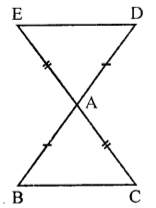
AE. Prove the segment DE $\| B C$.
Solution: Given : Sides $\mathrm{BA}$ and $\mathrm{CA}$ of $\triangle \mathrm{ABC}$ are produced such that
$B A=A D$ are $C A=A E . E D$ is
joined.
To prove : DE \| BC
Proof: In $\triangle \mathrm{ABC}$ and $\triangle \mathrm{DAE} \mathrm{AB}=\mathrm{AD}$ (Given)
$\mathrm{AC}=\mathrm{AE}$ (Given)
$\angle B A C=\angle D A E$ (Vertically opposite angles)
$\therefore \triangle \mathrm{ABC} \cong \triangle \mathrm{DAE}$ (SAS axiom)
$\therefore \angle \mathrm{ABC}=\angle \mathrm{ADE}$ (c.p.c.t.)
But there are alternate angles
$\therefore \mathrm{DE} \| \mathrm{BC}$
Question 2 . In a $\Delta \mathrm{PQR}$, if $\mathrm{PQ}=\mathrm{QR}$ and $\mathrm{L}, \mathrm{M}$ and $\mathrm{N}$ are the mid-points of the sides $\mathrm{PQ}, \mathrm{QR}$ and $\mathrm{RP}$ respectively. Prove that $\mathrm{LN}=\mathrm{MN}$.
Solution: Given : $\ln \Delta \mathrm{PQR}, \mathrm{PQ}=\mathrm{QR}$
$\mathrm{L}, \mathrm{M}$ and $\mathrm{N}$ are the mid points of the sides $\mathrm{PQ}, \mathrm{QR}$ and $\mathrm{PR}$ respectively
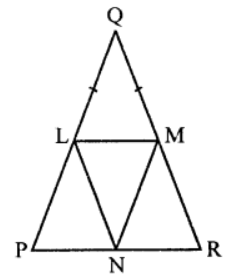
To prove : $L M=M N$
Proof : $\ln \Delta \mathrm{LPN}$ and $\Delta \mathrm{MRH}$
$\mathrm{PN}=\mathrm{RN}(\because \mathrm{M}$ is mid point of $\mathrm{PR})$
$\mathrm{LP}=\mathrm{MR}$ (Half of equal sides)
$\angle \mathrm{P}=\angle \mathrm{R}$ (Angles opposite to equal sides)
$\therefore \mathrm{ALPN} \cong$ AMRH (SAS axiom)
$\therefore \mathrm{LN}=\mathrm{MN}$ (c.p.c.t.)
Question $3 .$ Prove that the medians of an equilateral triangle are equal.
Solution: Given : In $\triangle \mathrm{ABC}, \mathrm{AD}, \mathrm{BE}$ and $\mathrm{CF}$ are the medians of triangle and $\mathrm{AB}=\mathrm{BC}=\mathrm{CA}$
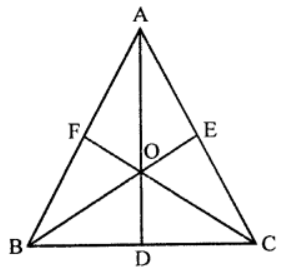
To prove : $A D=B E=C F$
Proof : In $\Delta \mathrm{BCE}$ and $\Delta \mathrm{BCF}$,
$\mathrm{BC}=\mathrm{BC}$ (Common side)
$\mathrm{CE}=\mathrm{BF}$ (Half of equal sides)
$\angle C=\angle B$ (Angles opposite to equal sides)
$\therefore \mathrm{ABCE} \cong \mathrm{ABCF}$ (SAS axiom)
$\therefore \mathrm{BE}=\mathrm{CF}($ c.p.c.t. $) \ldots(\mathrm{i})$
Similarly, we can prove that
$\therefore \Delta \mathrm{CAD} \cong \Delta \mathrm{CAF}$
$\therefore \mathrm{AD}=\mathrm{CF} \ldots$(ii)
From (i) and (ii) $B E=C F=A D$
$\Rightarrow \mathrm{AD}=\mathrm{BE}=\mathrm{CF}$
Question $4 .$ In a $\triangle \mathrm{ABC}$, if $\angle \mathrm{A}=120^{\circ}$ and $\mathrm{AB}=\mathrm{AC}$. Find $\angle \mathrm{B}$ and $\angle \mathrm{C}$.
Solution: In $\Delta \mathrm{ABC}, \angle \mathrm{A}=120^{\circ}$ and $\mathrm{AB}=\mathrm{AC}$
\therefore \angle \mathrm{B}=\angle \mathrm{C} \text { (Angles opposite to equal sides) }
But $\angle A+\angle B+\angle C=180^{\circ}$ (Sum of angles of a triangle)
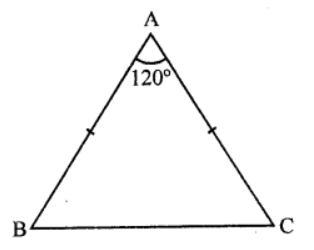
$\Rightarrow 120^{\circ}+\angle B+\angle B=180^{\circ}$
$\Rightarrow 2 \angle \mathrm{B}=180^{\circ}-120^{\circ}=60^{\circ}$
$\therefore \angle B=60.2=30^{\circ}$
and $\angle C=\angle B=30^{\circ}$
Hence $\angle B=30^{\circ}$ and $\angle C=30^{\circ}$
Question $5 .$ In a $\triangle \mathrm{ABC}$, if $\mathrm{AB}=\mathrm{AC}$ and $\angle \mathrm{B}=70^{\circ}$, find $\angle \mathrm{A}$.
Solution: In $\triangle \mathrm{ABC}, \angle \mathrm{B}=70^{\circ}$
$\mathrm{AB}=\mathrm{AC}$
$\therefore \angle \mathrm{B}=\angle \mathrm{C}$ (Angles opposite to equal sides)
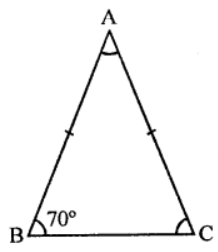
But $\angle B=70^{\circ}$
$\therefore \angle \mathrm{C}=70^{\circ}$
But $\angle A+\angle B+\angle C=180^{\circ}$ (Sum of angles of a triangle)
$\Rightarrow \angle A+70^{\circ}+70^{\circ}=180^{\circ}$ $\Rightarrow \angle A+140^{\circ}=180^{\circ}$
$\therefore \angle \mathrm{A}=180^{\circ}-140^{\circ}=40^{\circ}$ Question 6 . The vertical angle of an isosceles triangle is $100^{\circ}$. Find its base angles.
Solution: In $\Delta \mathrm{ABC}, \mathrm{AB}=\mathrm{AC}$ and $\angle \mathrm{A}=100^{\circ}$
But $A B=A C$ (In isosceles triangle)
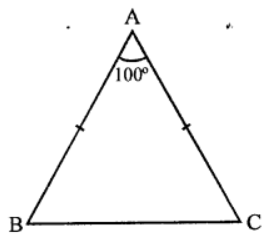
$\therefore \angle \mathrm{C}=\angle \mathrm{B}$ (Angles opposite to equal sides)
$\angle A+\angle B+\angle C=180^{\circ}$ (Sum of angles of a triangle)
$\Rightarrow 100^{\circ}+\angle B+\angle B=180^{\circ}(\because \angle C=\angle B)$
$\Rightarrow 2 \angle B=180^{\circ}-100^{\circ}=80^{\circ}$ $\therefore \angle \mathrm{C}=\angle \mathrm{B}=40^{\circ}$
Hence $\angle \mathrm{B}=40^{\circ}, \angle \mathrm{C}=40^{\circ}$
Question 7 . In the figure, $A B=A C$ and $\angle A C D=105^{\circ}$, find $\angle B A C$.
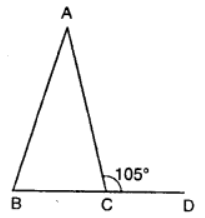
Solution: In $\triangle \mathrm{ABC}, \mathrm{AB}=\mathrm{AC}$
$\therefore \angle \mathrm{B}=\angle \mathrm{C}$ (Angles opposite to equal sides)
But $\angle A C B+\angle A C D=180^{\circ}$ (Linear pair)
$\Rightarrow \angle \mathrm{ACB}+105^{\circ}=180^{\circ}$
$\Rightarrow \angle \mathrm{ACB}=180^{\circ}-105^{\circ}=75^{\circ}$
$\therefore \angle \mathrm{ABC}=\angle \mathrm{ACB}=75^{\circ}$
But $\angle A+\angle B+\angle C=180^{\circ}$ (Sum of angles of a triangle)
$\Rightarrow \angle A+75^{\circ}+75^{\circ}=180^{\circ}$
$\Rightarrow \angle A+150^{\circ}=180^{\circ}$
$\Rightarrow \angle A=180^{\circ}-150^{\circ}=30^{\circ}$
$\therefore \angle B A C=30^{\circ}$
Question 8 . Find the measure of each exterior angle of an equilateral triangle.
Solution: In an equilateral triangle, each interior angle is $60^{\circ}$
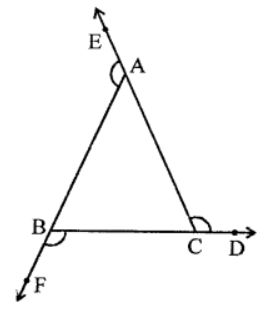
But interior angle $+$ exterior angle at each vertex $=180^{\circ}$
$\therefore$ Each exterior angle $=180^{\circ}-60^{\circ}=120^{\circ}$
Question $9 .$ If the base of an isosceles triangle is produced on both sides, prove that the exterior angles so formed are equal to each other.
Solution: Given : In an isosceles $\triangle \mathrm{ABC}, \mathrm{AB}=\mathrm{AC}$
and base $\mathrm{BC}$ is produced both ways
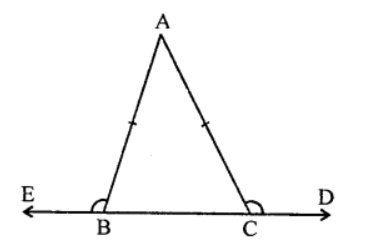
To prove : $\angle A C D=\angle A B E$
Proof: In $\triangle \mathrm{ABC}$
$\because \mathrm{AB}=\mathrm{AC}$
$\therefore \angle \mathrm{C}=\angle \mathrm{B}$ (Angles opposite to equal sides)
$\Rightarrow \angle \mathrm{ACB}=\angle \mathrm{ABC}$
But $\angle \mathrm{ACD}+\angle \mathrm{ACB}=180^{\circ}$ (Linear pair)
and $\angle A B E+\angle A B C=180^{\circ}$
$\therefore \angle \mathrm{ACD}+\angle \mathrm{ACB}=\angle \mathrm{ABE}+\angle \mathrm{ABC}$
But $\angle \mathrm{ACB}=\angle \mathrm{ABC}$ (Proved)
$\therefore \angle \mathrm{ACD}=\angle \mathrm{ABE}$
Hence proved.
Question 10 . In the figure, $A B=A C$ and $D B=D C$, find the ratio $\angle A B D: \angle A C D$.
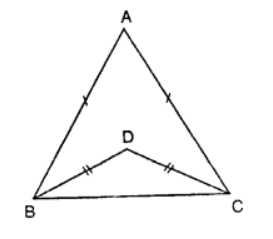
Solution: In the given figure,
In $\triangle \mathrm{ABC}$,
$A B=A C$ and $D B=D C$
In $\triangle \mathrm{ABC}$,
$\because \mathrm{AB}=\mathrm{AC}$
$\therefore \angle \mathrm{ACD}=\angle \mathrm{ABE} \ldots$ (i) (Angles opposite to equal sides)
Similarly, in $\triangle \mathrm{DBC}$,
$\mathrm{DB}=\mathrm{DC}$
$\therefore \angle \mathrm{DCB}=\angle \mathrm{DBC}$.. (ii)
Subtracting (ii) from (i)
$\angle A C B-\angle D C B=\angle A B C-\angle D B C$
$\Rightarrow \angle A C D=\angle A B D$
$\therefore$ Ratio $\angle A B D: \angle A C D=1: 1$
Question 11 .Determine the measure of each of the equal angles of a rightangled isosceles triangle.
OR
$A B C$ is a rightangled triangle in which $\angle A=90^{\circ}$ and $A B=A C$. Find $\angle B$ and $\angle C$.
Solution: Given : In a right angled isosceles $\triangle \mathrm{ABC}, \angle \mathrm{A}=90^{\circ}$ and $\mathrm{AB}=\mathrm{AC}$
To determine, each equal angle of the triangle
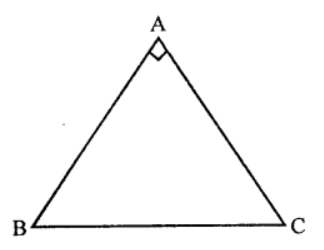
$\because \angle A=90^{\circ}$
$\therefore \angle \mathrm{B}+\angle \mathrm{C}=90^{\circ}$
But $\angle B=\angle C$
$\therefore \angle \mathrm{B}+\angle \mathrm{B}=90^{\circ}$
$\Rightarrow 2 \angle \mathrm{B}=90^{\circ}$
$90^{\circ}$
$\Rightarrow \angle B=90.2=45^{\circ}$
and $\angle \mathrm{C}=\angle \mathrm{B}=45^{\circ}$
Hence $\angle B=\angle C=45^{\circ}$
Question $12 .$ In the figure, $P Q R S$ is a square and $S R T$ is an equilateral triangle. Prove that
(i) $\mathrm{PT}=\mathrm{QT}$
(ii) $\angle \mathrm{TQR}=15^{\circ}$
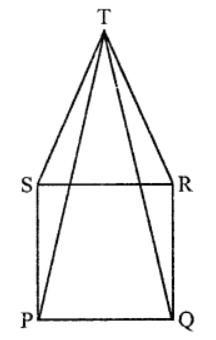
Solution: Given : $\mathrm{PQRS}$ is a square and SRT is an equilateral triangle. $\mathrm{PT}$ and $\mathrm{QT}$ are joined.
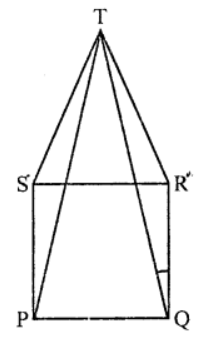
To prove : (i) $\mathrm{PT}=\mathrm{QT}$; (ii) $\angle \mathrm{TQR}=15^{\circ}$
Proof : In $\Delta$ TSP and $\Delta$ TQR
$\mathrm{ST}=\mathrm{RT}$ (Sides of equilateral triangle)
SP $=P Q$ (Sides of square)
and $\angle \mathrm{TSP}=\angle \mathrm{TRQ}\left(\right.$ Each $\left.=60^{\circ}+90^{\circ}\right)$
$\therefore \Delta \mathrm{TSP} \cong \Delta \mathrm{TQR}$ (SAS axiom)
$\therefore \mathrm{PT}=\mathrm{QT}$ (c.p.c.t.)
In $\Delta \mathrm{TQR}$,
$\because \mathrm{RT}=\mathrm{RQ}$ (Square sides)
$\angle \mathrm{RTQ}=\angle \mathrm{RQT}$
But $\angle \mathrm{TRQ}=60^{\circ}+90^{\circ}=150^{\circ}$
$\therefore \angle \mathrm{RTQ}+\angle \mathrm{RQT}=180^{\circ}-150^{\circ}=30^{\circ}$
$\because \angle \mathrm{PTQ}=\angle R Q T$ (Proved)
$\angle \mathrm{RQT}=30_{\circ} 2=15^{\circ}$
$\Rightarrow \angle \mathrm{TQR}=15^{\circ}$
Question $13 .$ $\mathrm{AB}$ is a line segment. $\mathrm{P}$ and $\mathrm{Q}$ are points on opposite sides of $\mathrm{AB}$ such that each of them is equidistant from the ponits $A$ and $B$ (see figure). Show that the line $P Q$ is perpendicular bisector of $A B$.
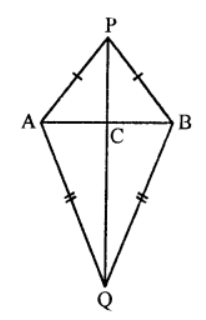
Solution: Given : $A B$ is a line segment.
$\mathrm{P}$ and $\mathrm{Q}$ are points such that they are equidistant from $\mathrm{A}$ and $\mathrm{B}$
i.e. $\mathrm{PA}=\mathrm{PB}$ and $\mathrm{QA}=\mathrm{QB} \mathrm{AP}, \mathrm{PB}, \mathrm{QA}, \mathrm{QB}, \mathrm{PQ}$ are joined
To prove : $\mathrm{PQ}$ is perpendicular bisector of $\mathrm{AB}$
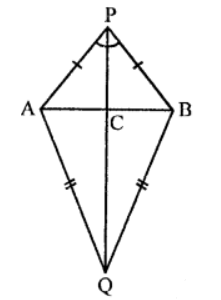
Proof : In $\Delta \mathrm{PAQ}$ and $\Delta \mathrm{PBQ}$,
$P A=P B$ (Given)
$\mathrm{QA}=\mathrm{QB}$ (Given)
$\mathrm{PQ}=\mathrm{PQ}$ (Common)
$\therefore \Delta \mathrm{PAQ} \cong \Delta \mathrm{PBQ}$ (SSS axiom)
$\therefore \angle \mathrm{APQ}=\angle \mathrm{BPQ}$ (c.p.c.t.)
Now in $\triangle A P C=\triangle B P C$
$P A=P B$ (Given)
$\Delta \mathrm{APC} \cong \Delta \mathrm{BPC}$ (Proved)
$\mathrm{PC}=\mathrm{PC}$ (Common)
$\therefore \Delta \mathrm{APC}=\Delta \mathrm{BPC}$ (SAS axiom)
$\therefore \mathrm{AC}=\mathrm{BC}$ (c.p.c.t.)
and $\angle$ PCA $=\angle P C B$ (c.p.c.t.)
But $\angle \mathrm{PCA}+\angle \mathrm{PCB}=180^{\circ}$ (Linear pair)
$\therefore \angle \mathrm{PCA}=\angle \mathrm{PCB}=90^{\circ}$
$\therefore \mathrm{PC}$ or $\mathrm{PQ}$ is perpendicular bisector of $\mathrm{AB}$
Question $1 .$ $\mathrm{BD}$ and $\mathrm{CE}$ are bisectors of $\angle \mathrm{B}$ and $\angle \mathrm{C}$ of an isosceles $\angle \mathrm{ABC}$ with $\mathrm{AB}=\mathrm{AC}$. Prove that
$B D=C E$
Solution: Given : $\ln \Delta \mathrm{ABC}, \mathrm{AB}=\mathrm{AC}$
$\mathrm{BD}$ and $\mathrm{CE}$ are the bisectors of $\angle \mathrm{B}$ and $\angle \mathrm{C}$ respectively
To prove : $B D=C E$
Proof: In $\Delta \mathrm{ABC}, \mathrm{AB}=\mathrm{AC}$ $\therefore \angle \mathrm{B}=\angle \mathrm{C}$ (Angles opposite to equal sides)
$\therefore 12 \angle \mathrm{B}=12 \angle \mathrm{C}$
RD Sharma Class 9 Solutions Chapter 12 Heron's Formula Ex $12.2-1$
$\angle D B C=\angle E C B$
Now, in $\triangle \mathrm{DBC}$ and $\Delta \mathrm{EBC}$,
$\mathrm{BC}=\mathrm{BC}$ (Common)
$\angle \mathrm{C}=\angle \mathrm{B}$ (Equal angles)
$\angle \mathrm{DBC}=\angle \mathrm{ECB}$ (Proved)
$\therefore \Delta \mathrm{DBC} \cong \Delta \mathrm{EBC}$ (ASA axiom)
$\therefore \mathrm{BD}=\mathrm{CE}$
Question 2 . In the figure, it is given that $\mathrm{RT}=\mathrm{TS}, \angle 1=2 \angle 2$ and $\angle 4=2 \angle 3$. Prove that: $\triangle \mathrm{RBT}=$ $\triangle$ SAT.
Solution: Given : In the figure, $\mathrm{RT}=\mathrm{TS}$
$\angle 1=2 \angle 2$ and $\angle 4=2 \angle 3$
To prove $: \Delta \mathrm{RBT} \cong \Delta \mathrm{SAT}$
Proof : : $\angle 1$ = $\angle 4$ (Vertically opposite angles)
But $\angle 1=2 \angle 2$ and $4=2 \angle 3$
$\therefore 2 \angle 2=2 \angle 3 \Rightarrow \angle 2=\angle 3$
$\because \mathrm{RT}=\mathrm{ST}$ (Given)
$\therefore \angle \mathrm{R}=\angle \mathrm{S}$ (Angles opposite to equal sides)
$\therefore \angle \mathrm{R}-\angle 2=\angle \mathrm{S}-\angle 3$
$\Rightarrow \angle \mathrm{TRB}=\angle \mathrm{AST}$
Now in $\Delta \mathrm{RBT}$ and $\Delta$ SAT
$\angle T R B=\angle S A T$ (prove)
$\mathrm{RT}=\mathrm{ST}$ (Given)
$\angle T=\angle T$ (Common)
$\therefore \Delta \mathrm{RBT} \cong \Delta \mathrm{SAT}$ (SAS axiom)
Question $3 .$ Two lines $A B$ and $C D$ intersect at $O$ such that $B C$ is equal and parallel to $A D$. Prove that the lines $A B$ and $C D$ bisect at $O$.
Solution: Given : Two lines $A B$ and $C D$ intersect each other at $O$ such that $A D=B C$ and $A D \|$
$\mathrm{BC}$
To prove : $A B$ and $C D$ bisect each other
i. e. $A O=O B$ and $C O=O D$
Proof: In $\triangle \mathrm{AOD}$ and $\Delta \mathrm{BOC}$,
$A D=B C$ (Given)
$\angle A=\angle B$ (Alternate angles)
$\angle D=\angle C$ (Alternate angles)
$\therefore \Delta \mathrm{AOD} \cong \Delta \mathrm{BOC}$ (ASA axiom) $\therefore \triangle \mathrm{AOD} \cong \Delta \mathrm{BOC}$ (ASA axiom)
$A O=O B$ and $A O=O C$ (c.p.c.t.)
Hence $\mathrm{AB}$ and $\mathrm{CD}$ bisect each other.
Ex $12.3$
Question 1. In two right triangles one side an acute angle of one are equal to the corresponding side and angle of the other. Prove that the triangles are congruent.
Solution: Given : In $\Delta \mathrm{ABC}$ and $\Delta \mathrm{DEF}$,
$\angle B=\angle E=90^{\circ}$
$\angle C=\angle F$ $\mathrm{AB}=\mathrm{DE}$
To prove : $\triangle \mathrm{ABC}=\triangle \mathrm{DEF}$
Proof : In $\triangle \mathrm{ABC}$ and $\triangle \mathrm{DEF}$,
$\angle B=\angle E\left(\right.$ Each $\left.=90^{\circ}\right)$
$\angle C=\angle F$ (Given)
$\triangle \mathrm{ABC}=\triangle \mathrm{DEF}$ (AAS axiom)
Question $2 .$ If the bisector of the exterior vertical angle of a triangle be parallel to the base. Show that the triangle is isosceles.
Solution: Given : In $\triangle \mathrm{ABC}$. AE is the bisector of vertical exterior $\angle \mathrm{A}$ and $\mathrm{AE} \| \mathrm{BC}$ To prove : $\triangle \mathrm{ABC}$ is an isosceles
Proof: $\because \mathrm{AE} \| \mathrm{BC}$
$\therefore \angle 1=\angle \mathrm{B}$ (Corresponding angles)
$\angle 2=\angle \mathrm{C}$ (Alternate angle)
But $\angle 1=\angle 2(\because \mathrm{AE}$ is the bisector of $\angle \mathrm{CAD})$
$\therefore \angle \mathrm{B}=\angle \mathrm{C}$
$\therefore \mathrm{AB}=\mathrm{AC}$ (Sides opposite to equal angles)
$\therefore \Delta \mathrm{ABC}$ is an isosceles triangle
Question $3 .$ In an isosceles triangle, if the vertex angle is twice the sum of the base angles, calculate the angles of the triangle.
Solution: Given : $\ln \Delta \mathrm{ABC}, \mathrm{AB}=\mathrm{AC}$
$\angle A=2(\angle B+\angle C)$
To calculate: Base angles,
Let $\angle B=\angle C=x$
Then $\angle A=2(\angle B+\angle C)$
$=2(x+x)=2 x 2 x=4 x$
$\because$ Sum of angles of a triangle $=180^{\circ}$
$\therefore 4 x+x+x-180^{\circ} \Rightarrow 6 x=180^{\circ}$
$\Rightarrow \mathrm{X}=180.6=30^{\circ} \mathrm{O}$
$\therefore \angle B=\angle C=30$ and $\angle A=4 \times 30^{\circ}=120$
Question $4 .$ Prove that each angle of an equilateral triangle is $60^{\circ}$.
Solution: Given : $\triangle \mathrm{ABC}$ is an equilateral triangle
Proof: In $\triangle \mathrm{ABC}$
$\mathrm{AB}=\mathrm{AC}$ (Sides of an equilateral triangle)
$\therefore \angle C=\angle B \ldots(i)$
(Angles opposite to equal angles)
Similarly, $A B=B C$
$\therefore \angle \mathrm{C}=\angle \mathrm{A} .$ ...(ii)
From (i) and (ii),
$\angle A=\angle B=\angle C$
But $\angle A+\angle B+\angle C=180^{\circ}$ (Sum of angles of a triangle)
$\therefore \angle A=\angle B=\angle C=180.3=60^{\circ}$
Question $5 .$ Angles $A, B, C$ of a triangle $A B C$ are equal to each other. Prove that $\triangle A B C$ is equilateral.
Solution: Given : $\ln \Delta \mathrm{ABC}, \angle \mathrm{A}=\angle \mathrm{B}=\angle \mathrm{C}$
To prove : $\triangle \mathrm{ABC}$ is an equilateral
Proof: In $\triangle \mathrm{ABC}$
$\therefore \angle \mathrm{B}=\angle \mathrm{C}$ (Given)
$\therefore \mathrm{AC}=\mathrm{AB} \ldots$..(i) (Sides opposite to equal angles)
Similarly, $\angle C=\angle A$
$\therefore \mathrm{BC}=\mathrm{AB} \ldots$ii)
From (i) and (ii)
$\mathrm{AB}=\mathrm{BC}=\mathrm{CA}$
Hence $\triangle \mathrm{ABC}$ is an equilateral triangle
Question 6. $\mathrm{ABC}$ is a right angled triangle in which $\angle \mathrm{A}=90^{\circ}$ and $\mathrm{AB}=\mathrm{AC}$. Find $\angle \mathrm{B}$ and $\angle \mathrm{C}$.
Solution: $\ln \Delta \mathrm{ABC}, \angle \mathrm{A}=90^{\circ}$
$A B=A C$ (Given)
$\therefore \angle \mathrm{C}=\angle \mathrm{B}$ (Angles opposite to equal sides)
But $\angle B+\angle C=90^{\circ}\left(\because \angle B=90^{\circ}\right)$
$\therefore \angle \mathrm{B}=\angle \mathrm{C}=90.2=45^{\circ}$
Hence $\angle B=\angle C=45^{\circ}$
Question 7. $\mathrm{PQR}$ is a triangle in which $\mathrm{PQ}=\mathrm{PR}$ and $\mathrm{S}$ is any point on the side $\mathrm{PQ}$. Through $\mathrm{S}, \mathrm{a}$ line is drawn parallel to QR and intersecting $\mathrm{PR}$ at $\mathrm{T}$. Prove that $\mathrm{PS}=\mathrm{PT}$.
Solution: Given : In $\Delta \mathrm{PQR}, \mathrm{PQ}=\mathrm{PR}$
$\mathrm{S}$ is a point on $\mathrm{PQ}$ and $\mathrm{PT} \| \mathrm{QR}$
To prove : $\mathrm{PS}=\mathrm{PT}$
Proof : :ST || QR
$\therefore \angle \mathrm{S}=\angle \mathrm{Q}$ and $\angle \mathrm{T}=\angle \mathrm{R}$ (Corresponding angles)
But $\angle Q=\angle R(\because P Q=P R)$
$\therefore \mathrm{PS}=\mathrm{PT}$ (Sides opposite to equal angles)
Question $8 .$ In a $\triangle A B C$, it is given that $A B=A C$ and the bisectors of $\angle B$ and $\angle C$ intersect at $O$. If $M$ is a point on BO produced, prove that $\angle \mathrm{MOC}=\angle \mathrm{ABC}$.
Solution. Given : In $\triangle A B C, A B=A C$ the bisectors of $\angle B$ and $\angle C$ intersect at O. $M$ is any point on BO produced.
To prove : $\angle \mathrm{MOC}=\angle \mathrm{ABC}$
Proof: In $\triangle \mathrm{ABC}, \mathrm{AB}=\mathrm{BC}$
$\therefore \angle C=\angle B$
$\because \mathrm{OB}$ and $\mathrm{OC}$ are the bisectors of $\angle \mathrm{B}$ and $\angle \mathrm{C}$
$\therefore \angle 1=\angle 2=12 \angle \mathrm{B}$
Now in $\angle \mathrm{OBC}$,
Ext. $\angle M O C=$ Interior opposite angles $\angle 1+\angle 2$
$=\angle 1+\angle 1=2 \angle 1=\angle \mathrm{B}$
Hence $\angle \mathrm{MOC}=\angle \mathrm{ABC}$
Question $9 .$ $P$ is a point on the bisector of an angle $\angle A B C$. If the line through $P$ parallel to $A B$ meets $\mathrm{BC}$ at $\mathrm{Q}$, prove that triangle $\mathrm{BPQ}$ is isosceles. Solution: Given : In $\triangle \mathrm{ABC}, \mathrm{P}$ is a point on the bisector of $\angle \mathrm{B}$ and from $\mathrm{P}, \mathrm{RPQ} \| \mathrm{AB}$ is draw which meets $\mathrm{BC}$ in $\mathrm{Q}$
Proof : $\because \mathrm{BD}$ is the bisectors of $\mathrm{CB}$
$\therefore \angle 1=\angle 2$
$\because \mathrm{RPQ} \| \mathrm{AB}$
$\therefore \angle 1=\angle 3$ (Alternate angles)
But $\angle 1==\angle 2$ (Proved)
$\therefore \angle 2=\angle 3$
$\therefore \mathrm{PQ}=\mathrm{BQ}$ (sides opposite to equal angles)
$\therefore \Delta \mathrm{BPQ}$ is an isosceles
Question 10. $\mathrm{ABC}$ is a triangle in which $\angle \mathrm{B}=2 \angle \mathrm{C}, \mathrm{D}$ is a point on $\mathrm{BC}$ such that $\mathrm{AD}$ bisects $\angle \mathrm{BAC}=$ $72^{\circ}$.
Solution: Given: In $\triangle \mathrm{ABC}$,
$\angle B=2 \angle C, A D$ is the bisector of $\angle B A C A B=C D$
To prove $: \angle B A C=72^{\circ}$
Construction : Draw bisector of $\angle B$ which meets AD at O
RD Sharma Solutions Class 9 Chapter 12 Heron’s Formula 12.4
Question $1 .$ In the figure, it is given that $A B=C D$ and $A D=B C$. Prove that $\triangle A D C \cong \Delta C B A$.
Solution: Given : In the figure, $A B=C D, A D=B C$
To prove : $\triangle \mathrm{ADC}=\Delta \mathrm{CBA}$
Proof : In $\triangle A D C$ and $\Delta$ CBA
$C D=A B$ (Given)
$\mathrm{AD}=\mathrm{BC}$ (Given)
$C A=C A$ (Common)
$\therefore \Delta \mathrm{ADC} \cong \Delta$ CBA (SSS axiom)
Question 2 . In a APQR, if $P Q=Q R$ and $L, M$ and $N$ are the mid-points of the sides $P Q, Q R$ and $R P$ respectively. Prove that $\mathrm{LN}=\mathrm{MN}$.
Solution: Given : $\ln \Delta \mathrm{PQR}, \mathrm{PQ}=\mathrm{QR}$
$\mathrm{L}, \mathrm{M}$ and $\mathrm{N}$ are the mid-points of sides $\mathrm{PQ}, \mathrm{QR}$ and RP respectively. Join $\mathrm{LM}, \mathrm{MN}$ and LN
To prove $: \angle \mathrm{PNM}=\angle \mathrm{PLM}$
Proof : In $\Delta \mathrm{PQR}$
$\because \mathrm{M}$ and $\mathrm{N}$ are the mid points of sides $\mathrm{PR}$ and $\mathrm{QR}$ respectively
$\therefore \mathrm{MN} \| \mathrm{PQ}$ and $\mathrm{MN}=12 \mathrm{PQ} \ldots(\mathrm{i})$
$\therefore \mathrm{MN}=\mathrm{PL}$
Similarly, we can prove that
$\mathrm{LM}=\mathrm{PN}$
Now in $\Delta \mathrm{NML}$ and $\Delta \mathrm{LPN}$
$\mathrm{MN}=\mathrm{PL}$ (Proved)
$\mathrm{LM}=\mathrm{PN}$ (Proved)
$\mathrm{LN}=\mathrm{LN}($ Common $)$
$\therefore \Delta \mathrm{NML}=\Delta \mathrm{LPN}$ (SSS axiom)
$\therefore \angle M N L=\angle P L N$ (c.p.c.t.)
and $\angle M L N=\angle L N P$ (c.p.c.t.)
$\Rightarrow \angle M N L=\angle L N P=\angle P L M=\angle M L N$
$\Rightarrow \angle \mathrm{PNM}=\angle \mathrm{PLM}$
Class 9 RD Sharma Solutions Chapter 12 Heron’s Formula ex 12.5
Question $1 .$ $\mathrm{ABC}$ is a triangle and $\mathrm{D}$ is the mid-point of $\mathrm{BC}$. The perpendiculars from $\mathrm{D}$ to $\mathrm{AB}$ and $\mathrm{AC}$ are equal. Prove that the triangle is isosceles.
Solution: Given : In $\triangle \mathrm{ABC}, \mathrm{D}$ is mid-point of $\mathrm{BC}$ and $\mathrm{DE} \perp \mathrm{AB}, \mathrm{DF} \perp \mathrm{AC}$ and $\mathrm{DE}=\mathrm{DF}$
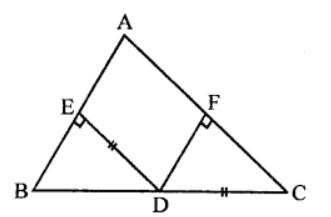
To Prove : $\triangle \mathrm{ABC}$ is an isosceles triangle
Proof : In right $\Delta \mathrm{BDE}$ and $\Delta \mathrm{CDF}$
Side $D E=D F$
Hyp. $B D=C D$
$\therefore \Delta \mathrm{BDE} \cong \Delta \mathrm{CDF}$ (RHS axiom)
$\therefore \angle \mathrm{B}=\angle \mathrm{C}$ (c.p.c.t.)
Now in $\triangle \mathrm{ABC}$,
$\angle B=\angle C$ (Prove)
$\therefore \mathrm{AC}=\mathrm{AB}$ (Sides opposite to equal angles)
$\therefore \mathrm{AABC}$ is an isosceles triangle
Question 2 . $\mathrm{ABC}$ is a triangle in which $\mathrm{BE}$ and $\mathrm{CF}$ are, respectively, the perpendiculars to the sides $A C$ and $A B$. If $B E=C F$, prove that $\triangle A B C$ is an isosceles.
Solution: Given : In $\triangle \mathrm{ABC}$,
$B E \perp A C$ and $C F \perp A B$
$\mathrm{BE}=\mathrm{CF}$
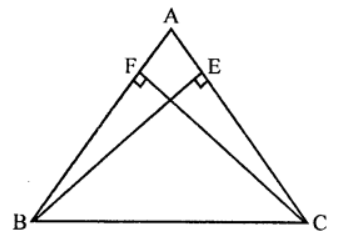
To prove : $A A B C$ is an isosceles triangle
Proof : In right $\mathrm{ABCE}$ and $\mathrm{ABCF}$ Side
$\mathrm{BE}=\mathrm{CF}$ (Given)
Hyp. BC = BC (Common)
$\therefore \Delta \mathrm{BCE} \cong \Delta \mathrm{BCF}$ (RHS axiom)
$\therefore \angle \mathrm{BCE}=\angle \mathrm{CBF}$ (c.p.c.t.)
$\therefore \mathrm{AB}=\mathrm{AC}$ (Sides opposite to equal angles)
$\therefore \Delta \mathrm{ABC}$ is an isosceles triangle
Question $3 .$ If perpendiculars from any point within an angle on its arms are congruent, prove that it lies on the bisector of that angle.
Solution: Given : A point $P$ lies in the angle $A B C$ and $P L \perp B A$ and $P M \perp B C$ and $P L=P M$. $P B$ is joined
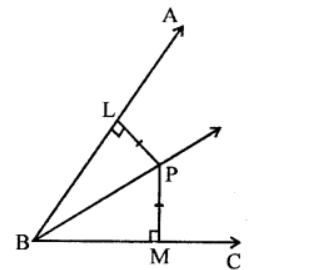
To prove : $\mathrm{PB}$ is the bisector $\angle \mathrm{ABC}$,
Proof : In right $\Delta \mathrm{PLB}$ and $\Delta \mathrm{PMB}$
Side $P L=$ PM (Given)
Hyp. $P B=P B$ (Common)
$\therefore \Delta \mathrm{PLB} \cong \Delta \mathrm{PMB}$ (RHS axiom)
$\therefore \Delta \mathrm{PBL}=\Delta \mathrm{PBM}$ (c.p.c.t.)
$\therefore \mathrm{PB}$ is the bisector of $\angle \mathrm{ABC}$
Question $4 .$ In the figure, $A D \perp C D$ and $C B \perp C D$. If $A Q=B P$ and $D P=C Q$, prove that $\angle D A Q=$ $\angle \mathrm{CBP}$.
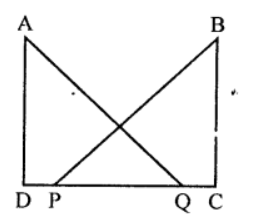
Solution: Given : In the figure,
$A D \perp C D$ and $C B \perp C D, A Q=B P$ and $D P=C Q$
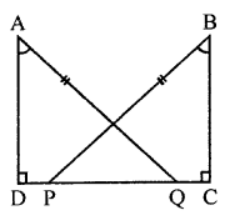
To prove : $\angle D A Q=\angle C B P$
Proof : $\because \mathrm{DP}=\mathrm{CQ}$
$\therefore \mathrm{DP}+\mathrm{PQ}=\mathrm{PQ}+\mathrm{QC}$
$\Rightarrow D Q=P C$
Now in right $\triangle \mathrm{ADQ}$ and $\Delta \mathrm{BCP}$
Side $\mathrm{DQ}=\mathrm{PC}$ (Proved)
Hyp. $A Q=B P$
$\therefore \Delta \mathrm{ADQ} \cong \Delta \mathrm{BCP}$ (RHS axiom)
$\therefore \angle \mathrm{DAQ}=\angle \mathrm{CBP}($ c.p.c.t. $)$
Question $5 .$ Which of the following statements are true $(T)$ and which are false $(F)$ :
(i) Sides opposite to equal angles of a triangle may be unequal.
(ii) Angles opposite to equal sides of a triangle are equal.
(iii) The measure of each angle of an equilateral triangle is $60^{\circ}$.
(iv) If the altitude from one vertex of a triangle bisects the opposite side, then the triangle may be isosceles.
(v) The bisectors of two equal angles of a triangle are equal.
(vi) If the bisector of the vertical angle of a triangle bisects the base, then the triangle may be isosceles.
(vii) The two altitudes corresponding to two equal sides of a triangle need not be equal.
(viii)If any two sides of a right triangle are respectively equal to two sides of other right triangle, then the two triangles are congruent.
(ix) Two right triangles are congruent if hypotenuse and a side of one triangle are respectively equal to the hypotenuse and a side of the other triangle.
Solution: (i) False : Sides opposite to equal angles of a triangle are equal.
(ii) True.
(iii) True. (iv) False : The triangle is an isosceles triangle.
(v) True.
(vi) False : The triangle is an isosceles.
(vii) False : The altitude an equal.
(viii) False : If one side and hypotenuse of one right triangle on one side and hypotenuse of the other right triangle are equal, then triangles are congruent.
(ix) True.
Question $6 .$ Fill in the blanks in the following so that each of the following statements is true.
(i) Sides opposite to equal angles of a triangle are ......
(ii) Angle opposite to equal sides of a triangle are ..
(iii) In an equilateral triangle all angles are $\ldots \ldots$
(iv) In a $\triangle \mathrm{ABC}$ if $\angle \mathrm{A}=\angle \mathrm{C}$, then $\mathrm{AB}=\ldots \ldots$
(v) If altitudes $\mathrm{CE}$ and $\mathrm{BF}$ of a triangle $\mathrm{ABC}$ are equal, then $\mathrm{AB}=\ldots \ldots \ldots$
(vi) In an isosceles triangle $\mathrm{ABC}$ with $\mathrm{AB}=\mathrm{AC}$, if $\mathrm{BD}$ and $\mathrm{CE}$ are its altitudes, then $\mathrm{BD}$ is ... CE.
(vii) In right triangles $\mathrm{ABC}$ and DEF, if hypotenuse $\mathrm{AB}=\mathrm{EF}$ and side $\mathrm{AC}=\mathrm{DE}$, then $\Delta \mathrm{ABC} \cong \Delta \ldots \ldots$
Solution: (i) Sides opposite to equal angles of a triangle are equal.
(ii) Angle opposite to equal sides of a triangle are equal.
(iii) In an equilateral triangle all angles are equal.
(iv) In a $\triangle \mathrm{ABC}$, if $\angle \mathrm{A}=\angle \mathrm{C}$, then $\mathrm{AB}=\mathrm{BC}$.
(v) If altitudes $C E$ and $B F$ of a triangle $A B C$ are equal, then $A B=A C$.
(vi) In an isosceles triangle $\mathrm{ABC}$ with $\mathrm{AB}=\mathrm{AC}$, if $\mathrm{BD}$ and $\mathrm{CE}$ are its altitudes, then $\mathrm{BD}$ is equal to CE.
(vii) In right triangles $A B C$ and DEF, it hypotenuse $A B=E F$ and side $A C=D E$, then $\triangle \mathrm{ABC} \cong \Delta \mathrm{EFD}$
Question 7. $\mathrm{ABCD}$ is a square, $\mathrm{X}$ and $\mathrm{Y}$ are points on sides $\mathrm{AD}$ and $\mathrm{BC}$ respectively such that $\mathrm{AY}=$ $B X$. Prove that $B Y=A X$ and $\angle B A Y=\angle A B X$.
Solution: Given : In square $\mathrm{ABCD}, \mathrm{X}$ and $\mathrm{Y}$ are points on side $\mathrm{AD}$ and $\mathrm{BC}$ respectively and $\mathrm{AY}=$ BX
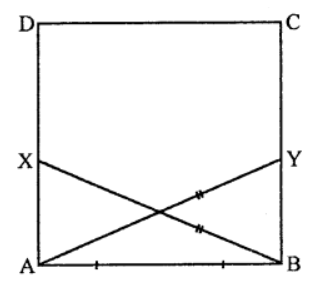
To prove : $B Y=A X$
$\angle B A Y=\angle A B X$
Proof: In right $\Delta \mathrm{BAX}$ and $\triangle \mathrm{ABY}$
$\mathrm{AB}=\mathrm{AB}$ (Common)
Hyp. $B X=$ AY (Given)
$\therefore \Delta \mathrm{BAX} \cong \Delta \mathrm{ABY}$ (RHS axiom)
$\therefore \mathrm{AX}=\mathrm{BY}$ (c.p.c.t.)
$\angle A B X=\angle B A Y$ (c.p.c.t.)
Hence, $B Y=A X$ and $\angle B A Y=\angle A B X$
Class 9 RD Sharma Solutions Chapter 12 Heron’s Formula 12.6
Question 1. In $\triangle \mathrm{ABC}$, if $\angle \mathrm{A}=40^{\circ}$ and $\angle \mathrm{B}=60^{\circ}$. Determine the longest and shortest sides of the triangle.
Solution: In $\Delta \mathrm{ABC}, \angle \mathrm{A}=40^{\circ}, \angle \mathrm{B}=60^{\circ}$
But $\angle A+\angle B+\angle C=180^{\circ}$
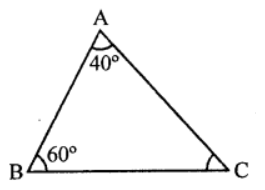
$\Rightarrow 40^{\circ}+60^{\circ}+\angle \mathrm{C}=180^{\circ}$
$\Rightarrow \angle C=180^{\circ}=\left(40^{\circ}+60^{\circ}\right)$
$=180^{\circ}-100^{\circ}=80^{\circ}$
$\because \angle \mathrm{C}=80^{\circ}$, which is the greatest angle and
$\angle A=40^{\circ}$ is the smallest angle
$\therefore$ Side $\mathrm{AB}$ which is opposite to the greatest angle is the longest and side $\mathrm{BC}$ which is opposite to the smallest angle is the shortest.
Question $2 .$ In a $\triangle \mathrm{ABC}$, if $\angle \mathrm{B}=\angle \mathrm{C}=45^{\circ}$. which is the longest side?
Solution: In $\Delta \mathrm{ABC}, \angle \mathrm{B}=\angle \mathrm{C}=45^{\circ}$
But $\angle A+\angle B+\angle C=180^{\circ}$
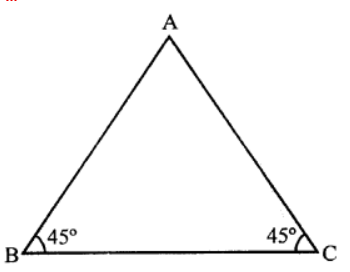
$\Rightarrow \angle A+45^{\circ}+45^{\circ}=180^{\circ}$
$\Rightarrow \angle \mathrm{A}+90^{\circ}=180^{\circ}$
$\therefore \angle \mathrm{A}=180^{\circ}-90^{\circ}=90^{\circ}$
$\therefore \angle \mathrm{A}$ is the greatest
$\therefore$ Side BC opposite to it is the longest
Question $3 .$ In $\triangle \mathrm{ABC}$, side $\mathrm{AB}$ is produced to $\mathrm{D}$ so that $\mathrm{BD}=\mathrm{BC}$. If $\angle \mathrm{B}=60^{\circ}$ and $\angle \mathrm{A}=70^{\circ}$, prove that :
(i) $A D>C D$
(ii) $A D>A C$
Solution: Given : In $A A B C$, side $B C$ is produced to $D$ such that $B D=B C$
$\angle A=70^{\circ}$ and $\angle B=60^{\circ}$
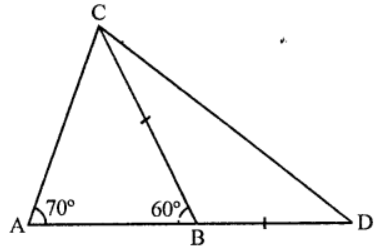
To prove:
(i) $\mathrm{AD}>\mathrm{CD}$ (ii) $\mathrm{AD}>\mathrm{AC}$
Proof: In $\triangle \mathrm{ABC}$
$\angle A=70^{\circ}, \angle B=60^{\circ}$
But Ext. $\angle C B D+\angle C B A=180^{\circ}$ (Linear pair)
$\angle C B D+60^{\circ}=180^{\circ} 3$
$\Rightarrow \angle \mathrm{CBD}=180^{\circ}-60^{\circ}=120^{\circ}$ But in $\triangle B C D$,
$B D=B C$
$\therefore \angle D=\angle B C D$
But $\angle D+\angle B C D=180^{\circ}-120^{\circ}=60^{\circ}$
$\therefore \angle \mathrm{D}=\angle \mathrm{BCD}=60.2=30^{\circ}$
and in $\triangle \mathrm{ABC}$,
$\angle A+\angle B+\angle C=180^{\circ}$
$\Rightarrow 70^{\circ}+60^{\circ}+\angle C=180^{\circ}$
$\Rightarrow 130^{\circ}+\angle \mathrm{C}=180^{\circ}$
$\therefore \angle \mathrm{C}=180^{\circ}-130^{\circ}=50^{\circ}$
Now $\angle A C D=\angle A C B+\angle B C D=50^{\circ}+30^{\circ}=80^{\circ}$
(i) Now in $\triangle \mathrm{ACB}$,
$\angle A C D=80^{\circ}$ and $\angle A=70^{\circ}$
$\therefore$ Side $A D>C D$
(Greater angle has greatest side opposite to it)
(ii) $\because \angle \mathrm{ACD}=80^{\circ}$ and $\angle \mathrm{D}=30^{\circ}$
$\therefore \mathrm{AD}>\mathrm{AC}$
Question $4 .$ Is it possible to draw a triangle with sides of length $2 \mathrm{~cm}, 3 \mathrm{~cm}$ and $7 \mathrm{~cm}$ ?
Solution: We know that in a triangle, sum of any two sides is greater than the third side and $2 \mathrm{~cm}$ $+3 \mathrm{~cm}=5 \mathrm{~cm}$ and $5 \mathrm{~cm}<7 \mathrm{~cm}$
$\therefore$ This triangle is not possible to draw
Question $5 .$ In $\triangle \mathrm{ABC}, \angle \mathrm{B}=35^{\circ}, \angle \mathrm{C}=65^{\circ}$ and the bisector of $\angle \mathrm{BAC}$ meets $\mathrm{BC}$ in $\mathrm{P}$. Arrange $\mathrm{AP}, \mathrm{BP}$ and $\mathrm{CP}$ in descending order.
Solution: In $\triangle \mathrm{ABC}, \angle \mathrm{B}=35^{\circ}, \angle \mathrm{C}=65^{\circ}$ and $\mathrm{AP}$ is the bisector of $\angle \mathrm{BAC}$ which meets $\mathrm{BC}$ in $\mathrm{P}$. Arrange PA, PB and $\mathrm{PC}$ in descending order In $\triangle \mathrm{ABC}$,
$\angle A+\angle B+\angle C=180^{\circ}$ (Sum of angles of a triangle)
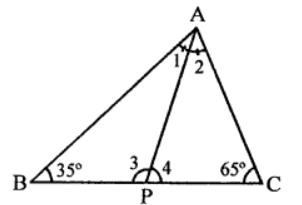
$\Rightarrow \angle A+35^{\circ}+65^{\circ}=180^{\circ}$
$\angle \mathrm{A}+100^{\circ}=180^{\circ}$
$\therefore \angle A=180^{\circ}-100^{\circ}=80^{\circ}$
$\because \mathrm{PA}$ is a bisector of $\angle \mathrm{BAC}$
$\therefore \angle 1=\angle 2=80 \circ 2=40^{\circ}$
Now in $\triangle \mathrm{ACP}, \angle \mathrm{ACP}>\angle \mathrm{CAP}$
$\Rightarrow \angle \mathrm{C}>\angle 2$
$\therefore \mathrm{AP}>\mathrm{CP} \ldots$(i)
Similarly, in $\triangle A B P$,
$\angle \mathrm{BAP}>\angle \mathrm{ABP} \Rightarrow \angle 1>\angle \mathrm{B}$
$\therefore \mathrm{BP}>\mathrm{AP} \ldots$(ii)
From (i) and (ii)
$\mathrm{BP}>\mathrm{AP}>\mathrm{CP}$
Question $6 .$ Prove that the perimeter of a triangle is greater than the sum of its altitudes
Solution: Given : In $\triangle \mathrm{ABC}$,
AD, BE and CF are altitudes
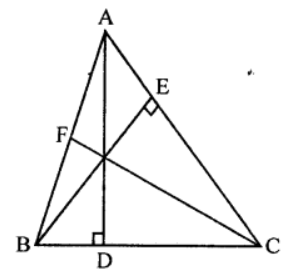
To prove $: \mathrm{AB}+\mathrm{BC}+\mathrm{CA}>\mathrm{AD}+\mathrm{BC}+\mathrm{CF}$
Proof: We know that side opposite to greater angle is greater.
In $\triangle \mathrm{ABD}, \angle \mathrm{D}=90^{\circ}$
$\therefore \angle \mathrm{D}>\angle \mathrm{B}$
$\therefore A B>A D \ldots(i)$
Similarly, we can prove that
$\mathrm{BC}>\mathrm{BE}$ and
$\mathrm{CA}>\mathrm{CF}$
Adding we get,
$\mathrm{AB}+\mathrm{BC}+\mathrm{CA}>\mathrm{AD}+\mathrm{BE}+\mathrm{CF}$
Question 7 . In the figure, prove that:
(i) $C D+D A+A B+B C>2 A C$
(ii) $C D+D A+A B>B C$
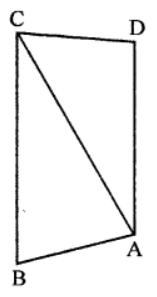
Solution: Given : In the figure, $A B C D$ is a quadrilateral and $A C$ is joined
To prove:
(i) $\mathrm{CD}+\mathrm{DA}+\mathrm{AB}+\mathrm{BC}>2 \mathrm{AC}$
(ii) $C D+D A+A B>B C$
Proof:
(i) In $\triangle \mathrm{ABC}$,
$A B+B C>A C$...(i)
(Sum of two sides of a triangle is greater than its third side)
Similarly in $\triangle \mathrm{ADC}$,
$\mathrm{CD}+\mathrm{DA}>\mathrm{AC}$
Adding (i) and (ii)
$\mathrm{CD}+\mathrm{DA}+\mathrm{AB}+\mathrm{BC}>\mathrm{AC}+\mathrm{AC}$
$\Rightarrow C D+D A+A B+B C>2 A C$
(ii) In $\Delta \mathrm{ACD}$
$\mathrm{CD}+\mathrm{DA}>\mathrm{CA}$
(Sum of two sides of a triangle is greater than its third side)
Adding $A B$ to both sides,
$\mathrm{CD}+\mathrm{DA}+\mathrm{AB}>\mathrm{CA}+\mathrm{AB}$
But $C A+A B>B C$ (in $\Delta A B C)$
$\therefore C D+D A+A D>B C$
Question $8 .$ Which of the following statements are true (T) and which are false (F)?
(i) Sum of the three sides of a triangle is less than the sum of its three altitudes.
(ii) Sum of any two sides of a triangle is greater than twice the median drawn to the third side.
(iii) Sum of any two sides of a triangle is greater than the third side.
(iv) Difference of any two sides of a triangle is equal to the third side.
(v) If two angles of a triangle are unequal, then the greater angle has the larger side opposite to it.
(vi) Of all the line segments that can be drawn from a point to a line not containing it, the perpendicular line segment is the shortest one.
Solution: (i) False. Sum of three sides of a triangle is greater than the sum of its altitudes.
(ii) True.
(iii) True.
(iv) False. Difference of any two sides is less than the third side.
(v) True.
(vi) True.
Question $9 .$ Fill in the blanks to make the following statements true.
(i) In a right triangle, the hypotenuse is the$\ldots \ldots .$side.
(ii) The sum of three altitudes of a triangle is $\ldots \ldots$ than its perimeter.
(iii) The sum of any two sides of a triangle is$\ldots \ldots \ldots$than the third side.
(iv) If two angles of a triangle are unequal, then the smaller angle has the $\ldots$ opposite to it.
(v) Difference of any two sides of a triangle is.... than the third side.
(vi) If two sides of a triangle are unequal, then the larger side has ……… angle opposite to it.
Solution: (i) In a right triangle, the hypotenuse is the longest side.
(ii) The sum of three altitudes of a triangle is less than its perimeter.
(iii) The sum of any two sides of a triangle is greater than the third side.
(iv) If two angles of a triangle are unequal, then the smaller angle has the smaller side opposite to it.
(v) Difference of any two sides of a triangle is less than the third side.
(vi) If two sides of a triangle are unequal, then the larger side has greater angle opposite to it.
Question 10 . $\mathrm{O}$ is any point in the interior of $\triangle \mathrm{ABC}$. Prove that
(i) $\mathrm{AB}+\mathrm{AC}>\mathrm{OB}+\mathrm{OC}$
(ii) $\mathrm{AB}+\mathrm{BC}+\mathrm{CA}>\mathrm{OA}+\mathrm{OB}+\mathrm{OC}$
(iii) $\mathrm{OA}+\mathrm{OB}+\mathrm{OC}>12(\mathrm{AB}+\mathrm{BC}+\mathrm{CA})$
Solution: Given : In $\triangle \mathrm{ABC}, \mathrm{O}$ is any point in the interior of the $\triangle \mathrm{ABC}, \mathrm{OA}, \mathrm{OB}$ and $\mathrm{OC}$ are joined
To prove:
(i) $\mathrm{AB}+\mathrm{AC}>\mathrm{OB}+\mathrm{OC}$
(ii) $\mathrm{AB}+\mathrm{BC}+\mathrm{CA}>\mathrm{OA}+\mathrm{OB}+\mathrm{OC}$
(iii) $\mathrm{OA}+\mathrm{OB}+\mathrm{OC}>12(\mathrm{AB}+\mathrm{BC}+\mathrm{CA})$
Construction : Produce BO to meet AC in D.
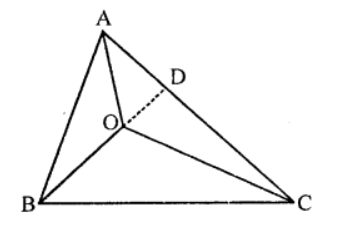
Proof: In $\triangle \mathrm{ABD}$,
(i) $A B+A D$ is greater than $B D$ (Sum of any two sides of a triangle is greater than third)
$\Rightarrow \mathrm{AB}+\mathrm{AD}>\mathrm{BO}+\mathrm{OD}$$\ldots$ (i)
Similarly, in $\Delta \mathrm{ODC}$,
$O D+D C$ is greater than $O C$..(ii)
Adding (i) and (ii)
$\mathrm{AB}+\mathrm{AD}+\mathrm{OD}+\mathrm{DC}>\mathrm{OB}+\mathrm{OD}+\mathrm{OC}$
$\Rightarrow \mathrm{AB}+\mathrm{AD}+\mathrm{DC}>\mathrm{OB}+\mathrm{OC}$
$\Rightarrow A B+A C$ is greater than $O B+O C$
(ii) Similarly, we can prove that
$\mathrm{BC}+\mathrm{AB}>\mathrm{OA}+\mathrm{OC}$
and $\mathrm{CA}+\mathrm{BC}>\mathrm{OA}+\mathrm{OB}$
(iii) In $\Delta \mathrm{OAB}, \mathrm{AOBC}$ and $\Delta \mathrm{OCA}$,
$\mathrm{OA}+\mathrm{OB}>\mathrm{AB}$
$\mathrm{OB}+\mathrm{OC}>\mathrm{BC}$
and $\mathrm{OC}+\mathrm{OA}>\mathrm{CA}$
Adding, we get
$2(\mathrm{OA}+\mathrm{OB}+\mathrm{OC})>\mathrm{AB}+\mathrm{BC}+\mathrm{CA}$
$\therefore \mathrm{OA}+\mathrm{OB}+\mathrm{OO}>12(\mathrm{AB}+\mathrm{BC}+\mathrm{CA})$
Question 11 .Prove that in a quadrilateral the sum of all the sides is greater than the sum of its diagonals.
Solution: Given : In quadrilateral $\mathrm{ABCD}, \mathrm{AC}$ and $\mathrm{BD}$ are its diagonals,
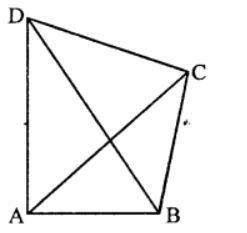
To prove : $A B+B C+C D+D A>A C+B D$
Proof: In $\Delta \mathrm{ABC}$,
$\mathrm{AB}+\mathrm{BC}>\mathrm{AC}$$\ldots(\mathrm{i})$
(Sum of any two sides of a triangle is greater than its third side)
Similarly, in $\triangle \mathrm{ADC}$
$\mathrm{DA}+\mathrm{CD}>\mathrm{AC}$$\ldots(\mathrm{ii})$
In $\Delta \mathrm{ABD}$
$\mathrm{AB}+\mathrm{DA}>\mathrm{BD}$…(iii)
In $\Delta \mathrm{BCD}$,
$\mathrm{BC}+\mathrm{CD}>\mathrm{BD} \ldots(\mathrm{iv})$
Adding (i), (ii), (iii) and (iv)
$2(\mathrm{AB}+\mathrm{BC}+\mathrm{CD}+\mathrm{DA})>2 \mathrm{AC}+2 \mathrm{BD}$ $\Rightarrow 2(\mathrm{AB}+\mathrm{BC}+\mathrm{CD}+\mathrm{DA})>2(\mathrm{AC}+\mathrm{BD})$
$\therefore \mathrm{AB}+\mathrm{BC}+\mathrm{CD}+\mathrm{DA}>\mathrm{AC}+\mathrm{BD}$
RD Sharma Solutions Class 9 Chapter 12 Heron's Formula VSAQS
Question 1 .
Solution: In two congruent triangles $A B C$ and DEF, if $A B=D E$ and $B C=E F$. Name the pairs of equal angles.
In AABC and ADEF,
$\Delta \mathrm{ABC} \cong \Delta \mathrm{DEF}$
and $A B=D E, B C=E F$
$\therefore \angle \mathrm{A}=\angle \mathrm{D}, \angle \mathrm{B}=\angle \mathrm{E}$ and $\angle \mathrm{C}=\angle \mathrm{F}$
RD Sharma Class 9 Solutions Chapter 12 Heron's Formula VSAQS – 1
Question 2.
Solution: In two triangles $A B C$ and $D E F$, it is given that $\angle A=\angle D, \angle B=\angle E$ and $\angle C=\angle F$. Are the two triangles necessarily congruent?
No, as the triangles are equiangular, so similar.
Question 3.
Solution: If $A B C$ and DEF are two triangles such that $A C=2.5 \mathrm{~cm}, B C=5 \mathrm{~cm}, \angle C=75^{\circ}, D E=$ $2.5 \mathrm{~cm}, \mathrm{DF}=5 \mathrm{~cm}$ and $\angle \mathrm{D}=75^{\circ}$. Are two triangles congruent?
Yes, triangles are congruent (SAS axiom)
RD Sharma Class 9 Solutions Chapter 12 Heron's Formula VSAQS – 3
Question 4.
Solution: In two triangles $\mathrm{ABC}$ and $\mathrm{ADC}$, if $\mathrm{AB}=\mathrm{AD}$ and $\mathrm{BC}=\mathrm{CD}$. Are they congruent?
Yes, these are congruent
In two triangles $A B C$ are $A D C$,
$A B=A D$ (Given)
$\mathrm{BC}=\mathrm{CD}$ (Given)
and $\mathrm{AC}=\mathrm{AC}$ (Common)
$\therefore \Delta \mathrm{sABC} \cong$ AADC (SSS axiom)
RD Sharma Class 9 Solutions Chapter 12 Heron's Formula VSAQS – 4
Question 5.
Solution: In triangles $A B C$ and $C D E$, if $A C=C E, B C=C D, \angle A=60^{\circ}, \angle C-30^{\circ}$ and $\angle D=90^{\circ} .$ Are two triangles congruent?
Yes, triangles are congruent because,
In $\Delta \mathrm{ABC}$, and $\Delta \mathrm{CDE}$
$\mathrm{AC}=\mathrm{CE}$
$B C=C D \angle C=30^{\circ}$
$\therefore \Delta \mathrm{ABC} \cong \Delta$ CDE (SAS axiom)
Question 6.
Solution: $\mathrm{ABC}$ is an isosceles triangle in which $\mathrm{AB}=\mathrm{AC}$. BE and $\mathrm{CF}$ are its two medians. Show that $\mathrm{BE}=\mathrm{CF}$.
Given : In $\triangle \mathrm{ABC}, \mathrm{AB}=\mathrm{AC}$
$\mathrm{BE}$ and $\mathrm{CF}$ are two medians
To prove : $B E=C F$
Proof: In $\Delta \mathrm{ABE}$ and $\triangle \mathrm{ACF}$.
$A B=A C$ (Given)
$\angle A=\angle A$ (Common)
$\mathrm{AE}=\mathrm{AF}$ (Half of equal sides)
$\therefore \Delta \mathrm{ABE} \cong \Delta \mathrm{ACF}$ (SAS axiom)
$\therefore \mathrm{BE}=\mathrm{CF}$ (c.p.c.t.)
Question 7.
Solution: Find the measure of each angle of an equilateral triangle.
In $\triangle \mathrm{ABC}$
$A B=A C=B C$
$\because \mathrm{AB}=\mathrm{AC}$
$\therefore \angle \mathrm{C}=\angle \mathrm{B}$$\cdots(\mathrm{i})$
(Angles opposite to equal sides)
Similarly,
$A C=B C$
$\therefore \angle \mathrm{B}=\angle \mathrm{A} \ldots$ (ii)
From (i) and (ii),
$\angle A=\angle B=\angle C$
But $\angle A+\angle B+\angle C=180^{\circ}$
(Sum of angles of a triangle)
$\therefore \angle A+\angle B+\angle C=180 \circ 3=60^{\circ}$
Question 8.
Solution: $\mathrm{CDE}$ is an equilateral triangle formed on a side $\mathrm{CD}$ of a square $\mathrm{ABCD}$. Show that $\triangle \mathrm{ADE}$ $\cong \Delta \mathrm{BCE} .$
Given : An equilateral ACDE is formed on the side of square ABCD. AE and BE are joined
To prove : $\triangle \mathrm{ADE} \cong \triangle \mathrm{BCE}$
Proot: In $\triangle A D E$ and $\Delta B C E$,
$A D=B C$ (Sides of a square)
$\mathrm{DE}=\mathrm{CE}$ (Sides of equilateral triangle)
$\angle \mathrm{ADE}=\angle \mathrm{BCE}\left(\right.$ Each $\left.=90^{\circ}+60^{\circ}=150^{\circ}\right)$
$\therefore \mathrm{AADE} \cong \mathrm{ABCE}$ (SAS axiom)
Question 9.
Solution: Prove that the sum of three altitude of a triangle is less than the sum of its sides.
Given : In $\triangle \mathrm{ABC}, \mathrm{AD}, \mathrm{BE}$ and $\mathrm{CF}$ are the altitude of $\triangle \mathrm{ABC}$
To prove $: \mathrm{AD}+\mathrm{BE}+\mathrm{CF}<\mathrm{AB}+\mathrm{BC}+\mathrm{CA}$
Proof : In right $\triangle \mathrm{ABD}, \angle \mathrm{D}=90^{\circ}$
Then other two angles are acute
$\because \angle \mathrm{B}<\angle \mathrm{D}$
$\therefore \mathrm{AD}<\mathrm{AB} \ldots$ (i)
Similarly, in $\Delta \mathrm{BEC}$ and $\triangle \mathrm{ABE}$ we can prove thatBE and $\mathrm{CF}<\mathrm{CA}$...(iii)
Adding (i), (ii), (iii)
$A D+B E-t C F$ is less than $A B+B C+C A$
Question 10.
Solution: In the figure, if $A B=A C$ and $\angle B=\angle C$. Prove that $B Q=C P$.
Given : In the figure, $A B=A C, \angle B=\angle C$
To prove : $B Q=C P$
Proof : In $\triangle \mathrm{ABQ}$ and $\triangle \mathrm{ACP}$
$A B=A C$ (Given)
$\angle \mathrm{A}=\angle \mathrm{A}$ (Common)
$\angle B=\angle C$ (Given)
$\therefore \Delta \mathrm{ABQ} \cong \Delta \mathrm{ACP}$ (ASA axiom)
$\therefore \mathrm{BQ}=\mathrm{CP}($ c.p.c.t. $)$
Class 9 RD Sharma Solutions Chapter 12 Heron's Formula MCQS
Mark the correct alternative in each of the following:
Question $1 .$ In $\triangle \mathrm{ABC} \cong \Delta \mathrm{LKM}$, then side of $\Delta \mathrm{LKM}$ equal to side $\mathrm{AC}$ of $\triangle \mathrm{ABC}$ is
(a) $L X$
(b) KM
(c) $L M$
(d) None of these
Solution: Side $A C$ of $\triangle A B C=L M$ of $\Delta L K M$ (c)
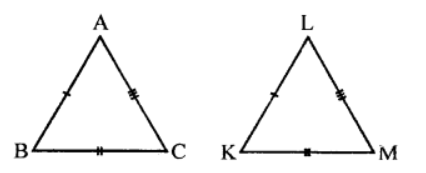
Question 2 . In $\triangle \mathrm{ABC} \cong \triangle \mathrm{ACB}$, then $\triangle \mathrm{ABC}$ is isosceles with
(a) $\mathrm{AB}=\mathrm{AC}$
(b) $A B=B C$
(c) $A C=B C$
(d) None of these
Solution: $\because \Delta \mathrm{ABC} \cong \Delta \mathrm{ACB}$
$\therefore \mathrm{AB}=\mathrm{AC}(\mathrm{a})$
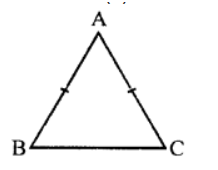
Question $3 .$ In $\triangle \mathrm{ABC} \cong \triangle \mathrm{PQR}$, then $\triangle \mathrm{ABC}$ is congruent to $\triangle \mathrm{RPQ}$, then which of the following is not true:
(a) $\mathrm{BC}=\mathrm{PQ}$
(b) $A C=P R$
(c) $\mathrm{AB}=\mathrm{PQ}$
(d) $Q R=B C$
Solution: $\because \Delta \mathrm{ABC}=\Delta \mathrm{PQR}$
$\therefore \mathrm{AB}=\mathrm{PQ}, \mathrm{BC}=\mathrm{QR}$ and $\mathrm{AC}=\mathrm{PR}$
$\therefore B C=P Q$ is not true $(a)$
Question $4 .$ In triangles $A B C$ and $P Q R$ three equality relations between some parts are as follows: $A B=Q P, \angle B=\angle P$ and $B C=P R$ State which of the congruence conditions applies:
(a) SAS
(b) ASA
(c) SSS
(d) RHS
Solution:
In two triangles $\triangle \mathrm{ABC}$ and $\Delta \mathrm{PQR}$,
$A B=Q P, \angle B=\angle P$ and $B C=P R$
The condition apply : SAS (a)
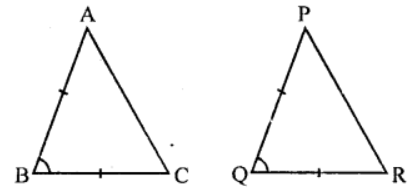
Question $5 .$ In triangles $A B C$ and $P Q R$, if $\angle A=\angle R, \angle B=\angle P$ and $A B=R P$, then which one of the following congruence conditions applies:
(a) SAS
(b) ASA
(c) SSS
(d) RHS
Solution: In $\triangle \mathrm{ABC}$ and $\Delta \mathrm{PQR}$,
$\angle \mathrm{A}=\angle \mathrm{R}$
$\angle B=\angle P$
$\mathrm{AB}=\mathrm{RP}$
$\therefore \Delta \mathrm{ABC} \cong \Delta \mathrm{PQR}(\mathrm{ASA}$ axiom $)(\mathrm{b})$
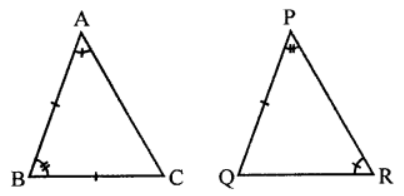
Question $6 .$ If $\Delta \mathrm{PQR} \cong \Delta \mathrm{EFD}$, then $\mathrm{ED}=$
(a) PQ
(b) QR
(c) PR
(d) None of these
Solution: $\because \Delta \mathrm{PQR}=\Delta \mathrm{EFD}$
$\therefore \mathrm{ED}=\mathrm{PR}(\mathrm{c})$
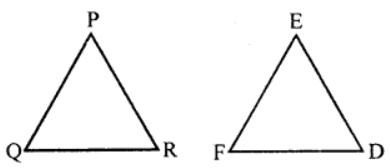
Question 7 . If $\Delta \mathrm{PQR} \cong \Delta \mathrm{EFD}$, then $\angle \mathrm{E}=$
(a) $\angle \mathrm{P}$
(b) $\angle Q$
(c) $\angle R$
(d) None of these
Solution: $\because \Delta \mathrm{PQR} \cong \Delta \mathrm{EFD}$
$\therefore \angle \mathrm{E}=\angle \mathrm{P}$ (a)
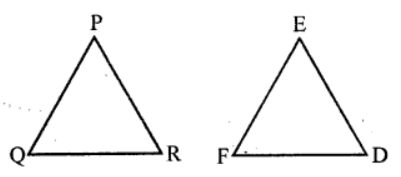
Question 8 . In a $\triangle \mathrm{ABC}$, if $\mathrm{AB}=\mathrm{AC}$ and $\mathrm{BC}$ is produced to $\mathrm{D}$ such that $\angle \mathrm{ACD}=100^{\circ}$, then $\angle \mathrm{A}=$
(a) $20^{\circ}$
(b) $40^{\circ}$
(c) $60^{\circ}$
(d) $80^{\circ}$
Solution: In $\Delta \mathrm{ABC}, \mathrm{AB}=\mathrm{AC}$
$\therefore \angle B=\angle C$
But Ext. $\angle \mathrm{ACD}=\angle \mathrm{A}+\angle \mathrm{B}$
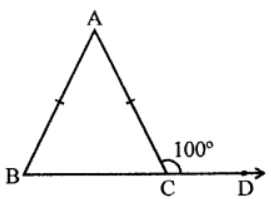
$\angle A C B+\angle A C D=180^{\circ}$ (Linear pair)
$\therefore \angle A C B+100^{\circ}=180^{\circ}$
$\Rightarrow \angle A C B=180^{\circ}-100^{\circ}=80^{\circ}$
$\therefore \angle \mathrm{B}=\angle \mathrm{ACD}=80^{\circ}$
But $\angle A+\angle B 4-\angle C=180^{\circ}$
$\therefore \angle A+80^{\circ}+80^{\circ}=180^{\circ}$
$\Rightarrow \angle \mathrm{A}+160^{\circ}=180^{\circ}$
$\therefore \angle \mathrm{A}=180^{\circ}-160^{\circ}=20^{\circ}(\mathrm{a})$
Question $9 .$ In an isosceles triangle, if the vertex angle is twice the sum of the base angles, then the measure of vertex angle of the triangle is
(a) $100^{\circ}$
(b) $120^{\circ}$
(c) $110^{\circ}$
(d) $130^{\circ}$
Solution: In $\triangle \mathrm{ABC}$,
$\angle A=2(\angle B+\angle C)$
$=2 \angle B+2 \angle C$
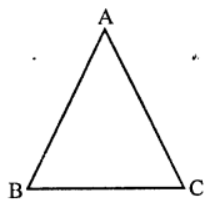
Adding $2 \angle A$ to both sides,
$\angle A+2 \angle A=2 \angle A+2 \angle B+2 \angle C$
$\Rightarrow 3 \angle \mathrm{A}=2(\angle \mathrm{A}+\angle \mathrm{B}+\angle \mathrm{C})$
$\Rightarrow 3 \angle \mathrm{A}=2 \times 180^{\circ}\left(\because \angle \mathrm{A}+\angle \mathrm{B}+\angle \mathrm{C}=180^{\circ}\right)$
$\Rightarrow 3 \angle A=360^{\circ}$
$\Rightarrow \angle \mathrm{A}=360 \circ 3=120^{\circ}$
$\therefore \angle \mathrm{A}=120^{\circ}$ (b)
Question $10 .$ Which of the following is not a criterion for congruence of triangles?
(a) SAS
(b) $\mathrm{SSA}$
(c) $\mathrm{ASA}$
(d) SSS
Solution: SSA is not the criterion of congruence of triangles. (b)
Question 11 . In the figure, the measure of $\angle \mathrm{B}^{\prime} \mathrm{A}^{\prime} \mathrm{C}$ ' is
(a) $50^{\circ}$
(b) $60^{\circ}$
(c) $70^{\circ}$
(d) $80^{\circ}$
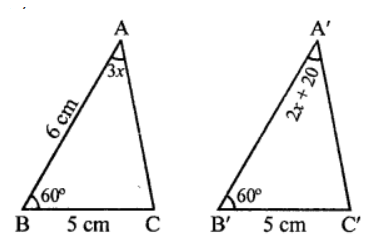
Solution: In the figure,
$\Delta \mathrm{ABC} \cong \Delta \mathrm{A}^{\prime} \mathrm{B}^{\prime} \mathrm{C}^{\prime}$
$\therefore \angle \mathrm{A}=\angle \mathrm{A}$
$\Rightarrow 3 x=2 x-+20$
$\Rightarrow 3 x-2 x=20$
$\Rightarrow x=20$
$\angle B^{\prime} A^{\prime} C^{\prime}=2 x+20=2 \times 20+20$
$=40+20=60^{\circ}$(b)
Question $12 .$ If $\mathrm{ABC}$ and $\mathrm{DEF}$ are two triangles such that $\triangle \mathrm{ABC} \cong \triangle \mathrm{FDE}$ and $\mathrm{AB}=5 \mathrm{~cm}, \angle \mathrm{B}=40^{\circ}$ and $\angle A=80^{\circ}$. Then, which of the following is true?
(a) $\mathrm{DF}=5 \mathrm{~cm}, \angle \mathrm{F}=60^{\circ}$
(b) $D E=5 \mathrm{~cm}, \angle E=60^{\circ}$
(c) $\mathrm{DF}=5 \mathrm{~cm}, \angle \mathrm{E}=60^{\circ}$
(d) $\mathrm{DE}=5 \mathrm{~cm}, \angle \mathrm{D}=40^{\circ}$
Solution: $\because \Delta \mathrm{ABC} \cong \Delta \mathrm{FDE}$
$\mathrm{AB}=5 \mathrm{~cm}, \angle \mathrm{A}=80^{\circ}, \angle \mathrm{B}=40^{\circ}$
$\therefore \mathrm{DF}=5 \mathrm{~cm}, \angle \mathrm{F}=80^{\circ}, \angle \mathrm{D}=40^{\circ}$
$\therefore \angle \mathrm{C}=180^{\circ}-\left(80^{\circ}+40^{\circ}\right)=180^{\circ}-120^{\circ}=60^{\circ}$
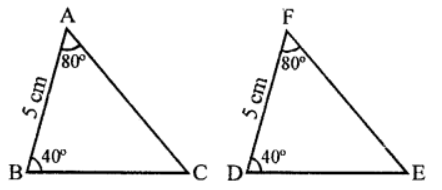
$\therefore \angle \mathrm{E}=\angle \mathrm{C}=60^{\circ}$
$\therefore \mathrm{DF}=5 \mathrm{~cm}, \angle \mathrm{E}=60^{\circ}(\mathrm{c})$
Question $13 .$ In the figure, $A B \perp B E$ and $F E \perp B E$. If $B C=D E$ and $A B=E F$, then $\triangle A B D$ is congruent to
(a) $\Delta \mathrm{EFC}$
(b) $\Delta \mathrm{ECF}$
(c) $\Delta \mathrm{CEF}$
(d) $\Delta \mathrm{FEC}$
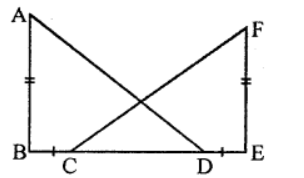
Solution: In the figure, $A B \perp B E, F E \perp B E$
$\mathrm{BC}=\mathrm{DE}, \mathrm{AB}=\mathrm{EF}$,
then $\mathrm{CD}+\mathrm{BC}=\mathrm{CD}+\mathrm{DE} \mathrm{BD}=\mathrm{CE}$
In $\triangle \mathrm{ABD}$ and $\Delta \mathrm{CEF}$,
$\mathrm{BD}=\mathrm{CE}$ (Prove)
$\mathrm{AB}=\mathrm{FE}($ Given $)$
$\angle B=\angle E\left(\right.$ Each $\left.90^{\circ}\right)$
$\therefore \Delta \mathrm{ABD} \cong \Delta \mathrm{FCE}$ (b)
Question 14 In the figure, if $A E \| D C$ and $A B=A C$, the value of $\angle A B D$ is
(a) $70^{\circ}$
(b) $110^{\circ}$
(c) $120^{\circ}$
(d) $130^{\circ}$
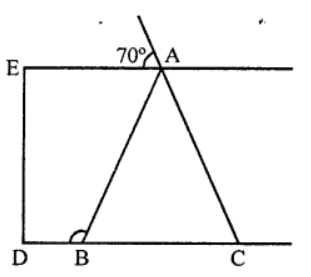
Solution: In the figure, $A E$ || DC
$\therefore \angle 1=70^{\circ}$ (Vertically opposite angles)
$\therefore \angle 1=\angle 2$ (Alternate angles)
$\angle 2=\angle \mathrm{ABC}$ (Base angles of isosceles triangle)
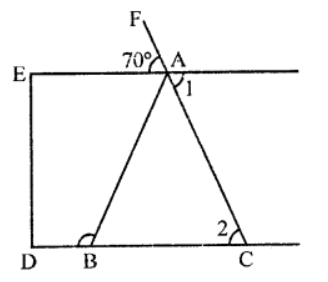
$\therefore \mathrm{ABC}=90^{\circ}$
But $\angle \mathrm{ABC}+\angle \mathrm{ABD}=180^{\circ}$ (Linear pair)
$\Rightarrow 70^{\circ}+\angle \mathrm{ABD}=180^{\circ}$
$\Rightarrow \angle \mathrm{ABD}=180^{\circ}-70^{\circ}=110^{\circ}$
$\therefore \angle \mathrm{ABD}=110^{\circ}$ (b
Question $15 .$ In the figure, $A B C$ is an isosceles triangle whose side $A C$ is produced to $E$. Through $C$, $\mathrm{CD}$ is drawn parallel to $\mathrm{BA}$. The value of $\mathrm{x}$ is
(a) $52^{\circ}$
(b) $76^{\circ}$
(c) $156^{\circ}$
(d) $104^{\circ}$
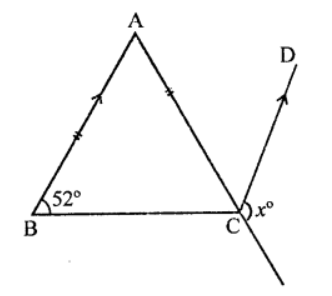
Solution: In $\triangle \mathrm{ABC}, \mathrm{AB}=\mathrm{AC}$
$A C$ is produced to $E$
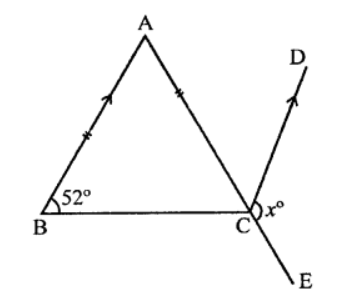
CD || BA is drawn
$\angle \mathrm{ABC}=52^{\circ}$
$\therefore \angle \mathrm{ACB}=52^{\circ}(\because \mathrm{AB}=\mathrm{AC})$
$\therefore \angle \mathrm{BAC}=180^{\circ}-\left(52^{\circ}+52^{\circ}\right)$
$=180^{\circ}-104^{\circ}=76^{\circ}$
$\because \mathrm{AB} \| \mathrm{CD}$
$\therefore \angle A C D=\angle B A C$ (Alternate angles)
$=76^{\circ}$
and $\angle \mathrm{BCE}+\angle \mathrm{DCB}=180^{\circ}$ (Linear pair)
$\angle B C E+52^{\circ}=180^{\circ}$
$\Rightarrow \angle \mathrm{BCE}=180^{\circ}-52^{\circ}=128^{\circ}$
$\angle x+\angle A C D=380^{\circ}$
$\Rightarrow \mathrm{x}+76^{\circ}=180^{\circ}$
$\therefore \mathrm{x}=180^{\circ}-76^{\circ}=104^{\circ} \mathrm{d}$
Question 16 . In the figure, if $A C$ is bisector of $\angle B A D$ such that $A B=3 \mathrm{~cm}$ and $A C=5 \mathrm{~cm}$, then $C D=$
(a) $2 \mathrm{~cm}$
(b) $3 \mathrm{~cm}$
(c) $4 \mathrm{~cm}$
(d) $5 \mathrm{~cm}$
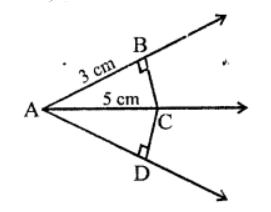
Solution: In the figure, $A C$ is the bisector of $\angle B A D, A B=3 c m, A C=5 \mathrm{~cm}$
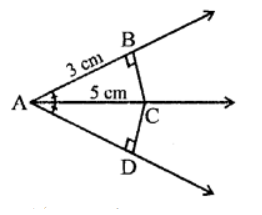
In $\triangle \mathrm{ABC}$ and $\triangle \mathrm{ADC}$,
$\mathrm{AC}=\mathrm{AC}$ (Common)
$\angle B=\angle D\left(\right.$ Each $\left.90^{\circ}\right)$
$\angle B A C=\angle D A C(\because A C$ is the bisector of $\angle A)$
$\therefore \Delta \mathrm{ABC} \cong \Delta \mathrm{ADC}$ (AAS axiom)
$\therefore \mathrm{BC}=\mathrm{CD}$ and $\mathrm{AB}=\mathrm{AD}$ (c.p.c.t.)
Now in right $\triangle \mathrm{ABC}$,
$\mathrm{AC}^{2}=\mathrm{AB}^{2}+\mathrm{BC}^{2}$
$\Rightarrow(5)^{2}=(3)^{2}+B C^{2}$
$\Rightarrow 25=9+B C^{2}$
$\Rightarrow \mathrm{BC}^{2}=25-9=16=(4)^{2}$
$\therefore \mathrm{BC}=4 \mathrm{~cm}$
But $C D=B C$
$\therefore C D=4 \mathrm{~cm}(c)$
Question 17 . $D, E, F$ are the mid-point of the sides $B C, C A$ and $A B$ respectively of $\triangle A B C$. Then $\Delta D E F$ is congruent to triangle
(a) $\mathrm{ABC}$
(b) $\mathrm{AEF}$
(c) $\mathrm{BFD}, \mathrm{CDE}$
(d) AFE, BFD, CDE
Solution. In $\Delta A B C, D, E, F$ are the mid-points of the sides $B C, C A, A B$ respectively DE, EF and FD are joined
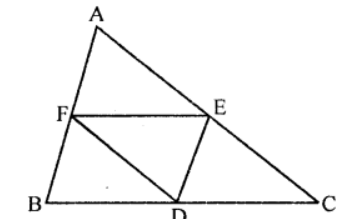
$\because \mathrm{E}$ and $\mathrm{F}$ are the mid-points
$A C$ and $A B$
$\therefore \mathrm{EF}=12 \mathrm{BC}$ and $\mathrm{EF} \| \mathrm{BC}$
Similarly,
$\mathrm{DE}=12 \mathrm{AB}$ and $\mathrm{DE} \| \mathrm{AB}$
$\mathrm{DF}=12 \mathrm{AC}$ and $\mathrm{DF} \| \mathrm{AC}$
$\therefore \Delta \mathrm{DEF}$ is congruent to each of the triangles so formed
$\therefore \Delta \mathrm{DEF}$ is congruent to triangle AFE, BFD, CDE (d)
Question 18 . $A B C$ is an isosceles triangle such that $A B=A C$ and $A D$ is the median to base $B C$.
Then, $\angle B A D=$
(a) $55^{\circ}$
(b) $70^{\circ}$
(c) $35^{\circ}$
(d) $110^{\circ}$
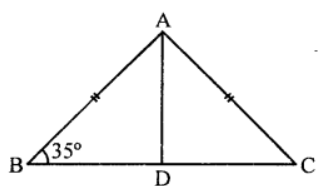
Solution: In $\Delta \mathrm{ABC}, \mathrm{AB}=\mathrm{AC}$
AD is median to BC
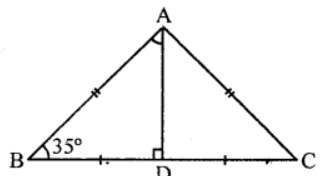
$\therefore \mathrm{BD}=\mathrm{DC}$
In $\triangle \mathrm{ADB}, \angle \mathrm{D}=90^{\circ}, \angle \mathrm{B}=35^{\circ}$
But $\angle B+B A D+\angle D=180^{\circ}$ (Sum of angles of a triangle)
$\Rightarrow 35^{\circ}+\angle B A D+90^{\circ}=180^{\circ}$
$\Rightarrow \angle \mathrm{BAD}+125^{\circ}=180^{\circ}$
$\Rightarrow \angle B A D=180^{\circ}-125^{\circ}$
$\Rightarrow \angle \mathrm{BAD}=55^{\circ}(\mathrm{a})$
Question $19 .$ In the figure, $X$ is a point in the interior of square $A B C D . A X Y Z$ is also a square. If $D Y=$ $3 \mathrm{~cm}$ and $\mathrm{AZ}=2 \mathrm{~cm}$, then $\mathrm{BY}=$
(a) $5 \mathrm{~cm}$
(b) $6 \mathrm{~cm}$
(c) $7 \mathrm{~cm}$
(d) $8 \mathrm{~cm}$
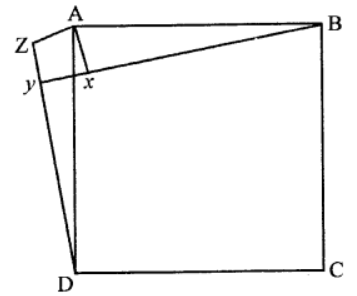
Solution: In the figure, $A B C D$ and $A X Y Z$ are squares
$\mathrm{DY}=3 \mathrm{~cm}, \mathrm{AZ}=2 \mathrm{~cm}$
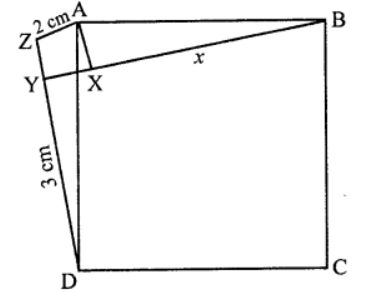
$\mathrm{DZ}=\mathrm{DY}+\mathrm{YZ}$
$=D Y+Z=3+2=5 \mathrm{~cm}$
In $\triangle \mathrm{ADZ} . \angle 2=90^{\circ}$
$\mathrm{AD}^{2}+\mathrm{AZ}^{2}+\mathrm{DZ}^{2}=2^{2}+5^{2} \mathrm{~cm}$
$=4+25=29$
$\ln \angle \mathrm{ABX}, \angle \mathrm{X}=90^{\circ}$
$\mathrm{AB}^{2}=\mathrm{AX}^{2}+\mathrm{BX}^{2}$
$\mathrm{AD}^{2}=\mathrm{AZ}^{2}+\mathrm{BX}^{2}$
$(\because \mathrm{AB}=\mathrm{AD}, \mathrm{AX}=\mathrm{AZ}$ sides of square $)$
$29=2^{2}+B X^{2}$
$\Rightarrow 29=4+B X^{2}$
$\Rightarrow \mathrm{BX}^{2}=29-4=25=(5)^{2}$
$\therefore \mathrm{BX}=5 \mathrm{~cm}(\mathrm{a})$
Question $20 .$ In the figure, $A B C$ is a triangle in which $\angle B=2 \angle C$. $D$ is a point on side $B C$ such that $A D$ bisects $\angle B A C$ and $A B=C D$. $B E$ is the bisector of $\angle B$. The measure of $\angle B A C$ is
Solution. (a) $72^{\circ}$
(b) $73^{\circ}$
(c) $74^{\circ}$
(d) $95^{\circ}$
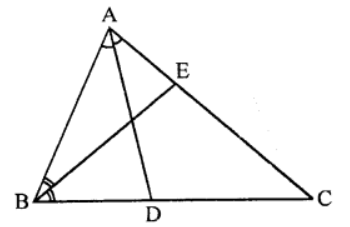
Solution: In the figure, $\angle B=2 \angle C, A D$ and $B E$ are the bisectors of $\angle A$ and $\angle B$ respectively,
$\mathrm{AB}=\mathrm{CD}$
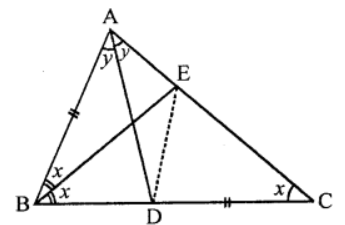
Let $\angle \mathrm{C}=x$, then $\angle \mathrm{B}=2 x$ ạnd
Let $\angle \mathrm{A}=2 y$
$\therefore \angle \mathrm{ABC}=\angle \mathrm{CBE}=x$
$\therefore \angle \mathrm{BAD}=\angle \mathrm{CAD}=y$ In $\triangle \mathrm{BCE}$,
$\therefore \angle \mathrm{EBC}=\angle \mathrm{BCE}=x$
$\therefore \mathrm{BE}=\mathrm{EC}$
In $\triangle \mathrm{ABE}$ and $\triangle \mathrm{DCE}$,
$\mathrm{AB}=\mathrm{DC}$ (Given)
$\angle A B E=\angle C \quad($ Each $=x)$
$\mathrm{BE}=\mathrm{EC}$ (Proved)
$\therefore \triangle \mathrm{ABE} \cong \Delta \mathrm{DCE}$ (SAS axiom)
$\therefore \angle \mathrm{BAE}=\angle \mathrm{EDC}=2 y$
and $\mathrm{AE}=\mathrm{ED}$
$\therefore \angle \mathrm{EAD}=\angle \mathrm{EDA}=y$
In $\triangle \mathrm{ABD}$,
Ext. $\angle \mathrm{ADC}=2 x+y=2 y+y$
$\Rightarrow 2 x=2 y \Rightarrow x=y$
Now in $\triangle \mathrm{ABC}$,
$\angle \mathrm{A}+\angle \mathrm{B}+\angle \mathrm{C}=180^{\circ}$
$\Rightarrow 2 y+2 x+x=180^{\circ} \Rightarrow 2 x+2 x+x=180^{\circ}$
$\Rightarrow 5 x=180^{\circ} \Rightarrow x=\frac{180^{\circ}}{5}=36^{\circ}$
$\therefore \angle \mathrm{BAC}=2 y=2 x=2 \times 36^{\circ}=72^{\circ}$(a)
Also Read,
Download NCERT Class 9 Maths Chapterwise Book Free PDF
Download NCERT Class 10 Maths Chapterwise Book Free PDF
Download NCERT Class 9 Maths Chapterwise Exemplar Free PDF
Download NCERT Class 10 Maths Chapterwise Exemplar Free PDF
If you have any Confusion related to RD Sharma Solutions for Class 9 Maths Chapter 12 Heron’s Formula, then feel free to ask in the comments section down below.
To watch Free Learning Videos on Class 9 by Kota’s top Faculties Install the eSaral App
